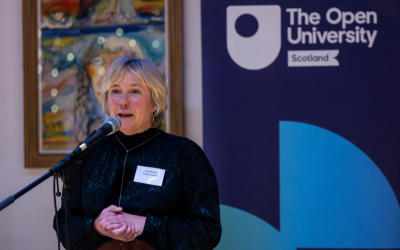Totem Latamat retired to The Crichton

An indigenous artwork, Totem Latamat, has completed a 9,000km trip from Mexico to the UK for COP26 and is now resting at The Crichton in Dumfries.
Stopping at iconic locations across England and Scotland, before arriving in Glasgow for the climate change conference COP26, Totem Latamat has now been returned to the Earth, emphasising the cyclical and transient nature of life and art.
Totem Latamat was carved by Totonac artist Jun Tiburcio. As part of Border Crossings’ ORIGINS Festival, Totem Latamat was a message from the Totanac people to our communities and world leaders, conveying how deeply interwoven our existence is with nature, and the need for immediate action to disrupt the damage done by climate change.
Totem Latamat was co-presented by Centro de las Artes Indígenas, The Open University and the Embassy of Mexico, and supported by The Crichton Trust during the final part of its journey to Dumfries.
MBP_8672%20-%20Crichton%20-%20web.jpg) Cut from a single cedar tree and standing at 4.5m tall, Totem Latamat demanded that neither it nor its message be ignored about the crucial role of Indigenous people and local communities in mitigating and adapting to the climate emergency.
Cut from a single cedar tree and standing at 4.5m tall, Totem Latamat demanded that neither it nor its message be ignored about the crucial role of Indigenous people and local communities in mitigating and adapting to the climate emergency.
Totem Latamat attracted interest from the local community during its first days in Dumfries including visits from regional schools and community groups.
A post-COP26 debate, reflecting on Totem Latamat’s journey, also took place on the Crichton Estate. The discussion was chaired by Michael Walling from Border Crossings, and involved Alexandra P. Alberda from Manchester Museum, plus The Open University's Graham Harvey, Professor of Religious Studies, and Stephen Peake, Professor of Climate Change and Energy.
During a 'Return to Earth Ceremony' on the grounds of The Crichton, Totem Latamat was laid to rest on the lawn where it will slowly decay over many years. Until then, Totem Latamat will act as a constant reminder about the need for individuals and communities to make changes that will protect the environment for future generations to enjoy.
Gordon MacLellan, Ecologist and educator from Creeping Toad, played a key role in the delivery of the school visit and chaired the ceremony with input from Professor Harvey and Michael Walling.
Michael Walling said: “Totem Latamat isn't a piece of visual art in the Western sense - it doesn't make sense to put it in a gallery, a sculpture park or a museum. It isn't about material value - it's about living interactions with places and spaces, people and communities.
“So, like everything which is alive, it has to die, and that's what the final ceremony at Dumfries was really all about. It's part of the environmental message from the Indigenous people who sent the totem: the artwork has its ecological sustainability contained within it.
“It's going to decay naturally as it lies in an area that is being rewilded, and so become, once again, a part of the Earth.”
Professor Harvey said: “For many Indigenous communities, art-works like Totem Latamat are respected as messengers in their own right. When they have done their job, they retire.
In retirement, Latamat will be returning carbon into soil, offering a good lesson about the ecology of life.”
“Having delivered a message at COP26, Totem Latamat is now restfully decaying back into the earth. It was always intended to be an active participant in vital (life-giving) events rather than a museum piece or a heritage symbol.
“In retirement, Latamat will be returning carbon into soil, offering a good lesson about the ecology of life. The Crichton in Dumfries is the perfect place for Totem Latamat’s retirement both because of its ecology and its education activities.
“Latamat is now becoming compost in an area of The Crichton’s large park which will be rewilded. The Crichton is also an important education centre, in which The Open University in Scotland has a key role, so the Totem’s success as a conveyer of Indigenous knowledge will be respected.”
Gwilym Gibbons, Chief Executive of The Crichton Trust said: “Totem Latamat really makes you think about our impact on the environment and what we, as individuals and as an organisation, can do to make a positive contribution towards becoming carbon Net Zero by 2030.
“It is a real privilege that this totem should find its final resting place here at The Crichton in Dumfries and we are honoured to have been involved in the final part of its extraordinary journey.
“There is something quite amazing about it being returned back to earth and as an object of curiosity, it is something people will visit and talk about for decades to come.”
Totem Latamat can be visited in its final resting place at The Crichton anytime. To arrange a group visit please contact The Crichton Trust.
News
Media contacts
Media enquiries
OU in Scotland Media Relations:
Call 0131 549 7932
OU UK Press Office:
Call 01908 654316
Out-of-hours:
07901 515 891
Visit our OU UK news site

